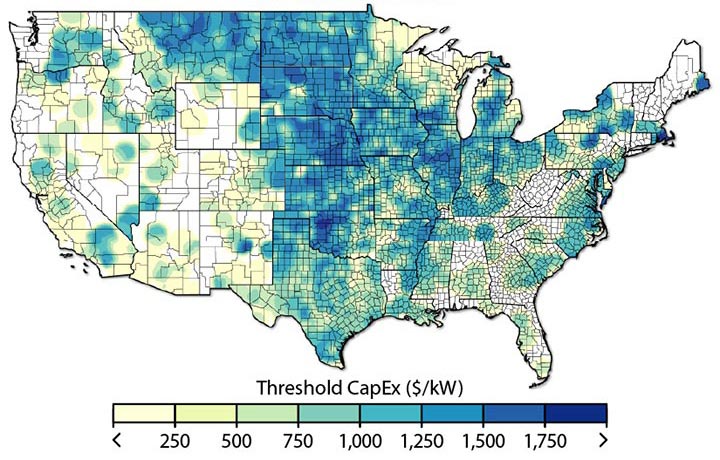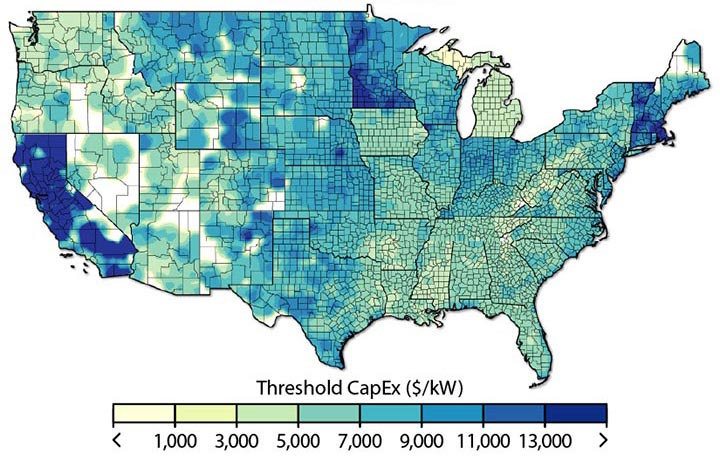The Future of Distributed Wind in the United States: Considerations for Unlocking Terawatt-Level Potential

The U.S. federal government has set a goal of 100% clean electricity in 2035 and a net-zero carbon economy in 2050. To achieve these ambitious targets, all forms of renewable power will be important—including distributed wind.
Distributed wind energy refers to wind technologies deployed as distributed energy resources. These technologies are place-based solutions that support individuals, communities, and businesses transitioning to carbon-free electricity.
Distributed wind can be placed in behind-the-meter applications, where the system directly offsets a specific end user's consumption of retail electricity supply, or in front-of-the-meter applications where the system is interconnected to the distribution network and provides community-scale energy supply while bolstering the robustness, reliability, and resiliency of the local distribution network. Distributed wind installations can range from a less-than-1-kilowatt off-grid wind turbine that powers telecommunications equipment to a 10-megawatt community-scale energy facility.
From 2003 through 2020, over 87,000 wind turbines were deployed in distributed applications across all 50 states, Puerto Rico, the U.S. Virgin Islands, and Guam, totaling 1,055 megawatts in cumulative capacity. Iowa, Minnesota, Massachusetts, California, and Texas lead the country with the most distributed wind capacity currently installed. As more communities come to understand the role that distributed energy resources could play in their own energy transitions and seek their environmental, economic, and social benefits, distributed wind could play a unique role in the future U.S. grid.
To explore opportunities for widespread deployment of distributed wind in 2035, the National Renewable Energy Laboratory (NREL) completed the Distributed Wind Energy Futures Study funded by the U.S. Department of Energy's Wind Energy Technologies Office. The highly detailed, comprehensive analysis reveals distributed wind has the potential to profitably provide nearly 1,400 gigawatts of capacity—today. That is enough energy to supply more than half of current U.S. annual electricity consumption.
But the right conditions must exist to realize the opportunities for distributed wind.
Modeling Innovations Provide Granular Insights
The Distributed Wind Energy Futures Study builds on NREL's 2016 first-ever exploratory analysis of future opportunities for behind-the-meter distributed wind systems.
For both the 2016 and 2022 studies, NREL used its Distributed Wind (dWind) model—a module within the Distributed Generation Market Demand (dGen™) model suite. This year, NREL added new, higher-resolution data and modeling capabilities to dWind to expand on the 2016 study. Notably, dWind now includes real-world dimensions from a data set of 150 million parcels of property in the United States to size turbines for those locations. NREL also improved dWind to consider front-of-the-meter wind systems. The model will be open sourced as part of dGen later this year.
"The potential of distributed wind projects can vary widely with local conditions, so it's important to study it at the most detailed level," said Kevin McCabe, NREL analyst and dGen developer. "Our study is one of the first demonstrations of parcel-level distributed energy resources analysis and advances wind economic and technical potential assessments with unprecedented resolution. With this new level of detail, we can identify trends by land-use type, end-use sector, and geography."
With these new modeling capabilities, dWind can now explore more community-scale distributed wind applications that could participate in the wholesale electricity market and a broader array of payment schemes. NREL modeled future scenarios with a variety of distributed wind system sizes in behind-the-meter and front-of-the-meter applications for specific land-use types, focusing on agricultural, commercial, and industrial areas.
Results: Economic Potential of Distributed Wind
Consistent with the 2016 study, NREL finds U.S. distributed wind has abundant economic potential, or the potential that would have a positive return on investment. Entire regions of the country could profitably provide hundreds of gigawatts today if deployed. In 2035, terawatts of capacity could be possible.
NREL examined three primary factors that could help unlock distributed wind's potential:
- Improved financing and performance to reduce the cost of wind energy
- Relaxed siting restrictions to open up more available land for wind development—a previous NREL study revealed a 7X difference in total U.S. wind technical potential in 2050 between the least and most restrictive siting restrictions
- An investment tax credit renewal and net metering. Currently, customers can receive a 26% tax credit for qualifying wind turbines below 100 kilowatts and solar panels installed between 2020 and 2022. The tax credit will expire in 2024 unless Congress renews it. Net metering is a metering and billing arrangement where distributed energy generation system owners are compensated for any generation that is not used and exported to the utility grid.
Under the most optimistic conditions—including aggressive cost declines, more relaxed siting constraints than today, and strategic extension and expansion of current tax credits and policies—NREL finds front-of-the-meter wind could provide over 4,000 gigawatts of capacity and behind-the-meter wind could provide over 1,700 gigawatts of capacity in 2035. In the least optimistic conditions, front-of-the-meter wind capacity decreases to 42 gigawatts and behind-the-meter wind capacity to 440 gigawatts in 2035.
"Our analysis suggests that technology cost reduction, performance improvements, and more relaxed siting restrictions are critical steps needed to realize the deployment potential of distributed wind," said Eric Lantz, principal investigator of the study. "At the same time, incentives like the investment tax credit, financing, and compensation mechanisms like net metering are also important to enhance system economics—and drive industry-wide growth that would fundamentally alter the outlook for distributed wind technologies."
Front-of-the-meter wind
Baseline 2022 Scenario

The economic potential of front-of-the-meter wind applications in 2022. Oklahoma, Nebraska, Illinois, Kansas, Iowa, South Dakota, Pennsylvania, New York, Montana, and New Mexico have the highest potential.
Behind-the-meter wind
Baseline 2022 Scenario

The economic potential of behind-the-meter wind applications in 2022. Texas, Minnesota, Montana, Colorado, Oklahoma, Indiana, South Dakota, North Dakota, New Mexico, and Kentucky have the greatest economic potential.
Results: Regions, Sectors With the Lowest-Hanging Fruit
NREL finds the regions with the highest potential for distributed wind tend to have a combination of high-quality wind, relatively high electricity rates for behind-the-meter applications, higher wholesale power rates for front-of-the-meter applications, and siting availability.
The Midwest and Heartland regions overall have the highest potential for distributed wind, and the Pacific and Northeast regions have significant potential for expansion of behind-the-meter distributed wind deployments.
As modeled, agricultural land has the highest distributed wind potential, but residential, commercial, and industrial land also have gigawatt-scale potential, particularly for behind-the-meter applications.
NREL finds states with the most near-term potential for behind-the-meter applications include Texas, Minnesota, Montana, Colorado, Oklahoma, and Indiana. States with the most near-term potential for front-of-the-meter applications include Oklahoma, Nebraska, Illinois, Kansas, Iowa, and South Dakota.
States across much of the Northeast as well as California have lower quantities of profitable distributed wind potential, but there are select locations with significant wind resources, which when combined with generally higher retail electricity rates in these regions means there are compelling opportunities in there too.
Results: Distributed Wind Potential in Disadvantaged Communities
Some communities have long endured the negative aspects of energy and climate change and face more barriers to accessing clean energy. On-site energy generation, like distributed wind, could help reduce this inequity by extending the benefits of clean energy to more communities.
NREL modeled the technical and economic potential of distributed wind in parcels of property in communities with high risk to environmental hazards and/or high proportions of low-income households.
As modeled, disadvantaged communities represent 43% of all suitable U.S. parcels for front-of-the-meter wind, and 47% for behind-the-meter wind. There are significant opportunities to expand distributed wind in disadvantaged communities in the next decade, particularly for behind-the-meter deployments in Texas, Montana, Michigan, and California.
"With continued efforts to reduce cost, improve performance, and think more broadly about solutions to deployment, distributed wind could empower communities across the United States to transition to clean energy," Lantz said. "Taking steps to help realize the potential of distributed wind will be especially important in future scenarios with a lot of wind energy, as envisioned under economy-wide decarbonization. In those scenarios, distributed wind's ability to fit specific niches and provide local electricity supply could advance the nation's ability to use wind energy."
Read the full Distributed Wind Energy Futures Study report. Learn more about NREL's Distributed Wind Research and Energy Analysis, as well as the Distributed Wind Research Program at the U.S. Department of Energy's Wind Technology's Office.
Learn More About the Distributed Wind Energy Futures Study at May 24 Webinar
To learn more about findings from the Distributed Wind Futures Study, join a free webinar from 12 to 1 p.m. MT on Tuesday, May 24. Please register to attend.
Comments (0)
This post does not have any comments. Be the first to leave a comment below.
Featured Product

